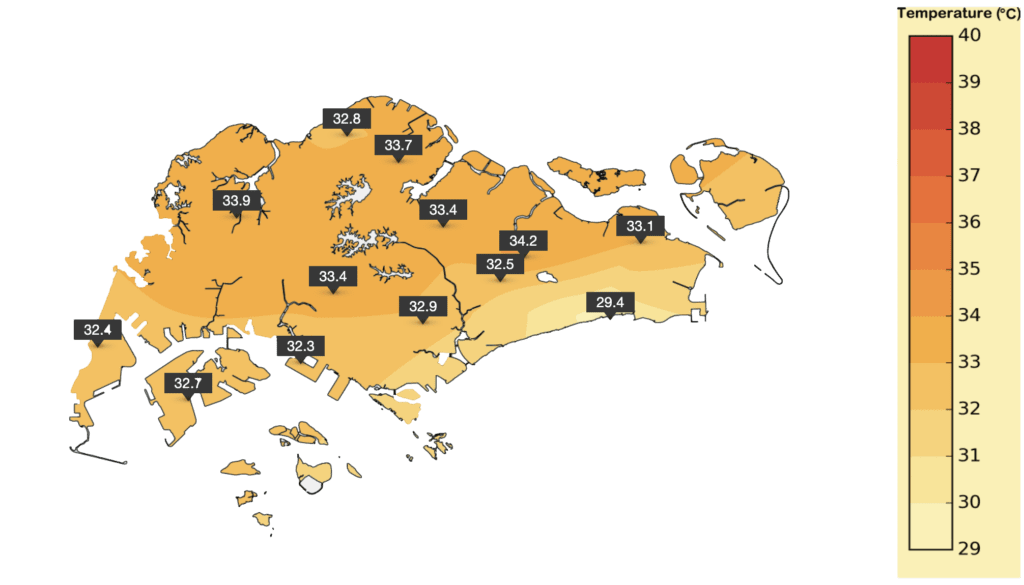BRB burning. If you’ve been sweating a lot more lately, you’re probably not the only one. People in Singapore and Malaysia have been cooking under the hot sun.
As the afternoon of March 24, 2024, approached, Singaporeans felt the mercury soaring to what felt like 38°C, a stark indicator of the relentless heat wave sweeping through the region. This sweltering climate, felt most acutely in Singapore, has not only made outdoor activities a challenge but has also raised concerns over the health implications of such extreme weather conditions. Meanwhile, our neighbors in Malaysia are grappling with the harsh realities of this extreme heat, with one reported death from heat stroke and 27 other heat-related incidents signaling an urgent public health issue.
As the afternoon of March 24, 2024, approached, Singaporeans felt the mercury soaring to what felt like 38°C, a stark indicator of the relentless heat wave sweeping through the region. This sweltering climate, felt most acutely in Singapore, has not only made outdoor activities a challenge but has also raised concerns over the health implications of such extreme weather conditions. Meanwhile, our neighbors in Malaysia are grappling with the harsh realities of this extreme heat, with one reported death from heat stroke and 27 other heat-related incidents signaling an urgent public health issue.
RELEVANT SUSTAINABLE GOALS



rising Temperatures in Singapore
Paya Lebar recorded an astounding high of 34.2°C, with no relief from rainfall. Similar scorching temperatures were reported in other parts of Singapore, like Choa Chu Kang and Changi. Despite the actual temperature, the “feels like” temperature, which considers humidity and wind speed, was even higher.
This phenomenon isn’t an anomaly but part of a worrying trend. Singapore recorded an annual average temperature of 28.2°C in 2023, marking it as the fourth warmest year since records began. The past decade has been the warmest on record, highlighting a clear and consistent pattern of rising temperatures, aligned with global warming trends.
The Equinox Phenomenon: A Surge in Malaysia’s Temperatures
The Malaysian Meteorological Department has forecasted a significant rise in temperatures, predicting that most areas across Peninsula Malaysia and Sabah will experience highs surpassing 35 degrees Celsius in the coming weeks. This surge is attributed to the equinox phenomenon, which MET Malaysia explains occurs twice annually, around March 20 and September 22, when the sun positions itself directly above the Equator. This alignment brings about a spike in temperatures, leading to widespread alerts throughout Malaysia. Authorities are urging the public to take precautions to mitigate the risks of heatstroke and other heat-related illnesses during this period, which is expected to persist until April.
The National Disaster Management Agency (NADMA) reported a heat stroke death and ongoing cases of heat-related illnesses. The relentless heat affects not only human health but also water reserves and crop production, posing significant challenges to farmers and aquaculture.
The ongoing spell of hot and dry weather isn’t just a health concern—it’s severely affecting crop production and the levels of dam water reserves. The National Disaster Management Agency (NADMA) has highlighted that two key dams are facing critical lows, with Sembrong Barat Dam in Johor at 33.64% capacity and Air Hitam Dam at 35.80%. This troubling trend spells worry for farmers and livestock owners across the region, who are grappling with the challenges posed by these arid conditions.
Both Singapore and Malaysia’s experiences serve as a stark reminder of the impacts of climate change and the urgent need for adaptive and preventive measures. As temperatures continue to rise, both nations face the critical task of navigating the complexities of a warming world, underscoring the importance of innovative solutions to mitigate the effects of extreme heat.
This situation begs a deeper investigation into how both countries, known for their robust technological and infrastructural capabilities, are planning to adapt to these unprecedented climatic changes. As we delve into the strategies being employed to combat the rising temperatures, it’s clear that a collaborative approach, encompassing policy changes, technological innovations, and community engagement, will be crucial in safeguarding the health and well-being of the populace and ensuring the sustainability of agricultural and water resources.
Lead image courtesy of bgFoto via Getty Images Signatures
You may also be interested in :
El Niño’s Impact On Global Summer Climate : A Historical Perspective




